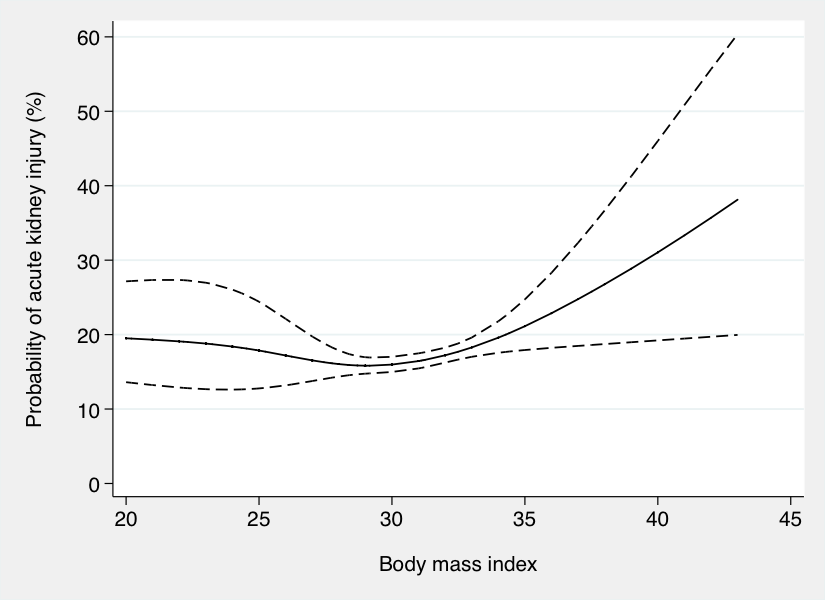Back
Poster, Podium & Video Sessions
Moderated Poster
MP50: Kidney Cancer: Localized: Surgical Therapy III
MP50-12: Body Mass Index, obesity and acute kidney injury after robot-assisted partial nephrectomy: results from a high-volume robotic center.
Sunday, May 15, 2022
4:30 PM – 5:45 PM
Location: Room 225
Marco Paciotti*, Carlo Andrea Bravi, Milan, Italy, Luca Sarchi, Modena, Italy, Angelo Mottaran, Pietro Piazza, Bologna, Italy, Alberto Martini, Milan, Italy, Fernando Gonzalez Meza, Marco Corsetti, Ghent, Belgium, Sophie Knipper, Hamburg, Germany, Marco Amato, Modena, Italy, Rui Farinha, Ghent, Belgium, Stefano Puliatti, Modena, Italy, Simone Scarcella, Celine Sinatti, Ghent, Belgium, Geert De Naeyer, Ruben De Groote, Alexandre Mottrie, Aalst, Belgium
Poster Presenter(s)
Introduction: Acute kidney injury (AKI) occurs in approximately 20% of patients receiving robot-assisted partial nephrectomies (RAPN), and it is associated with worse renal function at long-term follow-up. Body mass index (BMI) is a common health indicator, and a high BMI value-obesity has been shown to be associated with the outcomes of several diseases. However, the relationship between BMI and surgical AKI is still unclear. Therefore, we evaluated the association between BMI and AKI in patients receiving RAPN.
Methods: A total of 324 patients underwent RAPN at OLV hospital (Aalst, Belgium) from 2015 to 2020. AKI was defined according to the KDIGO criteria. Multivariable logistic regression models assessed the relationship between BMI (continuous) and AKI after surgery. To allow for a non-linear relationship between BMI and AKI, we included knots at quartiles. Patients were treated by five surgeons, and we incorporated surgeon clustering in our analysis. The adjustment for casemix included age, gender, preoperative creatinine, PADUA score, pathologic size, and ischemia time. In separate analyses, we investigated the association between obesity (BMI=30 according to WHO categories) and surgical AKI.
Results: Median (interquartile range) BMI was 27 (24, 30), and 91 (28%) patients had BMI=30. As compared to patients with BMI <30, obese patients were younger (median age 62 vs. 66 years; p=0.011), whereas gender, preoperative creatinine, PADUA score, pathologic size and ischemia time did not differ between the groups (all p=0.13). Overall, 68 (21%) patients had AKI after surgery, with no statistically significant difference between patients with BMI <30 vs. =30 (p=0.4). On multivariable analyses, we found a significant, non-linear relationship between BMI and AKI after surgery (p < 0.0001; Figure 1). Using BMI as categorical variable, obese patients had higher odds of AKI after surgery as compared to patients with BMI <30 (odds ratio: 1.31; 95% confidence interval: 1.07, 1.60; p=0.009).
Conclusions: We demonstrated an association between BMI and AKI after RAPN, with relevant implications for fluid therapy and medical management after surgery. Future investigations should focus on potential reasons that might trigger AKI in obese patients.
Source of Funding: None

Methods: A total of 324 patients underwent RAPN at OLV hospital (Aalst, Belgium) from 2015 to 2020. AKI was defined according to the KDIGO criteria. Multivariable logistic regression models assessed the relationship between BMI (continuous) and AKI after surgery. To allow for a non-linear relationship between BMI and AKI, we included knots at quartiles. Patients were treated by five surgeons, and we incorporated surgeon clustering in our analysis. The adjustment for casemix included age, gender, preoperative creatinine, PADUA score, pathologic size, and ischemia time. In separate analyses, we investigated the association between obesity (BMI=30 according to WHO categories) and surgical AKI.
Results: Median (interquartile range) BMI was 27 (24, 30), and 91 (28%) patients had BMI=30. As compared to patients with BMI <30, obese patients were younger (median age 62 vs. 66 years; p=0.011), whereas gender, preoperative creatinine, PADUA score, pathologic size and ischemia time did not differ between the groups (all p=0.13). Overall, 68 (21%) patients had AKI after surgery, with no statistically significant difference between patients with BMI <30 vs. =30 (p=0.4). On multivariable analyses, we found a significant, non-linear relationship between BMI and AKI after surgery (p < 0.0001; Figure 1). Using BMI as categorical variable, obese patients had higher odds of AKI after surgery as compared to patients with BMI <30 (odds ratio: 1.31; 95% confidence interval: 1.07, 1.60; p=0.009).
Conclusions: We demonstrated an association between BMI and AKI after RAPN, with relevant implications for fluid therapy and medical management after surgery. Future investigations should focus on potential reasons that might trigger AKI in obese patients.
Source of Funding: None


.jpg)
.jpg)
